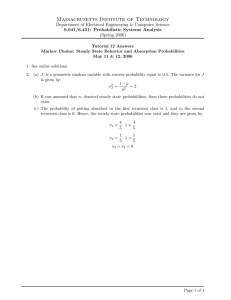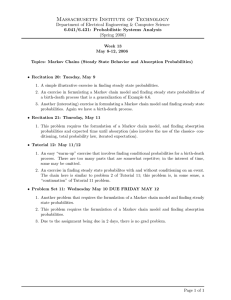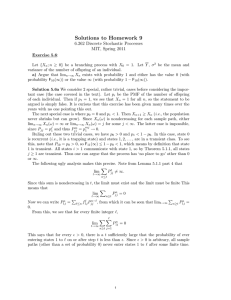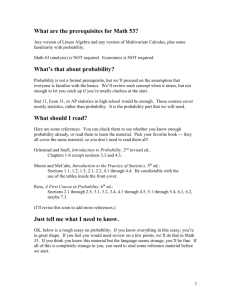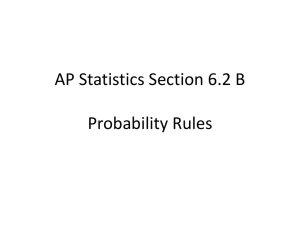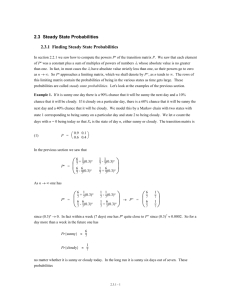Steady State Probabilities
advertisement
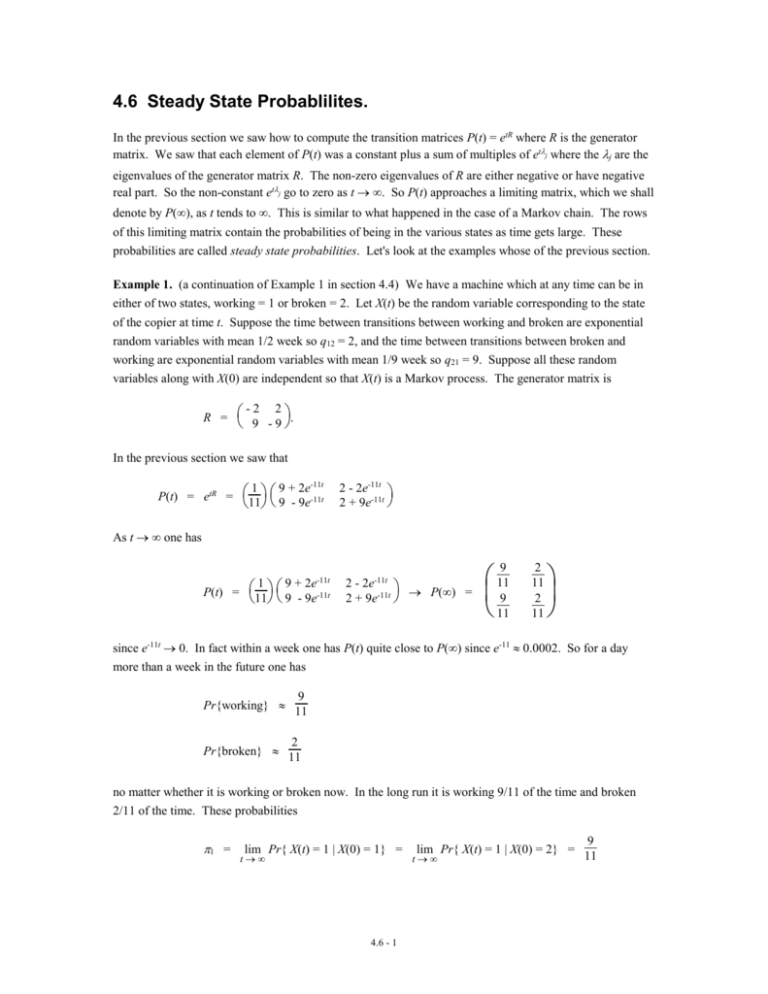
4.6 Steady State Probablilites.
In the previous section we saw how to compute the transition matrices P(t) = etR where R is the generator
matrix. We saw that each element of P(t) was a constant plus a sum of multiples of etj where the j are the
eigenvalues of the generator matrix R. The non-zero eigenvalues of R are either negative or have negative
real part. So the non-constant etj go to zero as t . So P(t) approaches a limiting matrix, which we shall
denote by P(), as t tends to . This is similar to what happened in the case of a Markov chain. The rows
of this limiting matrix contain the probabilities of being in the various states as time gets large. These
probabilities are called steady state probabilities. Let's look at the examples whose of the previous section.
Example 1. (a continuation of Example 1 in section 4.4) We have a machine which at any time can be in
either of two states, working = 1 or broken = 2. Let X(t) be the random variable corresponding to the state
of the copier at time t. Suppose the time between transitions between working and broken are exponential
random variables with mean 1/2 week so q12 = 2, and the time between transitions between broken and
working are exponential random variables with mean 1/9 week so q21 = 9. Suppose all these random
variables along with X(0) are independent so that X(t) is a Markov process. The generator matrix is
R =
- 2 2 .
9 -9
In the previous section we saw that
1 9 + 2e-11t
11 9 - 9e
-11t
P(t) = etR =
2 - 2e-11t
2 + 9e-11t
As t one has
11
9
11
9
1 9 + 2e-11t
11 9 - 9e
-11t
P(t) =
2 - 2e
2 + 9e-11t P() =
-11t
2
11
2
11
since e-11t 0. In fact within a week one has P(t) quite close to P() since e-11 0.0002. So for a day
more than a week in the future one has
Pr{working}
Pr{broken}
9
11
2
11
no matter whether it is working or broken now. In the long run it is working 9/11 of the time and broken
2/11 of the time. These probabilities
1 =
lim Pr{ X(t) = 1 | X(0) = 1} =
t
4.6 - 1
lim Pr{ X(t) = 1 | X(0) = 2} =
t
9
11
2 =
lim Pr{ X(t) = 2 | X(0) = 1} =
t
lim Pr{ X(t) = 2 | X(0) = 2} =
t
2
11
are called the steady state probabilities of being in states 1 and 2. In many applications of Markov
processes the steady state probabilities are the main items of interest since one is interested in the long run
behavior of the system. For the time being we shall assume the following about the generator matrix R.
(1)
The eigenvalue zero is not repeated.
(2)
The other eigenvalues are negative or have negative real part.
Then t
0
T
0
1
P(t) = etR = TetDT-1 =
0
0
0
etn
T
0
et2
-1
approaches
1 t12
1
t22
P() =
1 tn2
=
t1n 1
t2n 0
tnn 0
0
0
0
0
T
0
0
21
12
22
1n
2n
n1
n2
nn
0
0
1
0
1
1 0
0
0
11
-1
0
1
1
0
=
1 0
0
1
2
2
n
n
1
2
n
1
=
0
0
T -1
where we let
21
2
22
n
2n
n1
n2
nn
1
T -1 =
So
1
2
2
n
n
1
2
n
1
P() =
So the rows of P() are all equal to the vector which is the first row of T-1 which is a left eigenvector of R
with eigenvalue 0. In other words
(3)
R = 0
4.6 - 2
where
= (1, 2, …, n)
So the rows of P() are vectors which are solutions of the equation R = 0 and which are probability
vectors, i.e. the sum of the entries of equals 1. The entries of are called steady state probabilities.
Another way to see that the rows of P() satisfy (3) is to start with the Kolmogoroff equation
and let t . Since P(t) P() one has
for
dP(t)
= P(t)R
dt
dP(t)
P()R. However, the only way this can be consistent is
dt
dP(t)
o. So P()R = 0. Since the ith row of P()R is the ith row of P() times R we see the rows of
dt
P() satistfy (3).
Example 1 (continued). Find the steady state vector = (1, 2) in Example 1.
Since R = 0 we get
-2 2
(1, 2) 9 - 9 = (0, 0)
Therefore
- 21 + 92 = 0
21 + 92 = 0
Therefore 2 = 21/9
In order to find 1 and 2 we need to use the fact that 1 + 2 = 1. Combining this with 2 = 21/9 gives 1 +
21/9 = 1 or 111/9 = 1 or 1 = 9/11 and 2 = 2/11.
Example 2. (see Example 1 of section 4.1) The condition of an office copier at any time t is either
0.05
0.15
- 0.2
0.48 . The
good = 1, poor = 2 or broken = B. Suppose the generator matrix is R = 0.02 - 0.5
0.48 0.12 - 0.6
equation R = 0 is
- 0.21 + 0.052
+ 0.153 = 0
0.021 -
+ 0.483 = 0
0.52
0.481 + 0.122 -
0.63 = 0
These equations are dependent and when we solve them we get 1 = 4043/165 and 1 = 163/33. Using 1
+ 2 + 3 = 1 we get 4043/165 + 163/33 + 3 = 1. Thus 6493/165 = 1 or 3 = 165/649 0.254 and
1 = 404/649 0.622 and2 = 80/649 0.123.
4.6 - 3
